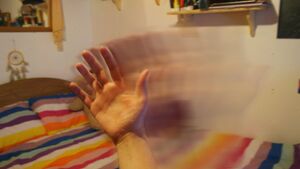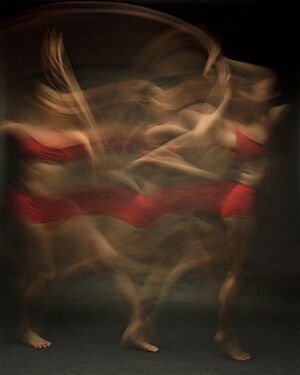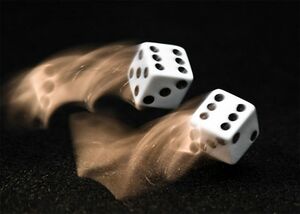Tracers
Tracers are defined as the experience of trails of varying lengths and opacity being left behind moving objects in a manner that is similar to those found in long exposure photography.[1] These can manifest as exactly the same colour of the moving object which is producing it or can sometimes be a randomly selected colour of their own.
A relatively consistent way to reproduce this visual effect is to simply move one's hand in front of their face or throw an object under the influence of a moderate dose of psychedelics.
This effect is capable of manifesting itself across the 4 different levels of intensity described below:
- Subtle - At the lowest level, tracers can be described as an almost completely transparent after image which disappears quickly and drags closely behind moving objects.
- Distinct - At this level, tracers increase in length to become roughly half as long as the distance across the visual field which the object it is following has travelled. The clarity of these tracers shifts from barely visible to distinct and partially transparent in colour.
- Intense - At this level, tracers become mostly solid in appearance and almost completely opaque with increasingly distinct and sharp edges. This creates a clear contrast between the tracer itself and the background behind it. The tracers become slower to fade from a person's vision and can remain in the air for up to several seconds. This results in longer trails covering the entire distance across the visual field which the object creating it has moved.
- All-encompassing - At the highest level, a person’s visual field has become so sensitive to the creation of tracers that it entirely smudges and blurs into an all-encompassing tracer at the slightest movement of an object or the eye. This can make it extremely difficult to see unless one's eyes are kept still in a motionless environment as tracers linger almost indefinitely or until one looks elsewhere within their visual field.
Tracers are often accompanied by other coinciding effects such as drifting and after images. They are most commonly induced under the influence of mild dosages of psychedelic[2][3] compounds, such as LSD[4][5][6][7], psilocybin, and mescaline. However, they can also occur less commonly under the influence of certain stimulants and dissociatives such as MDMA or 3-MeO-PCP.
Image examples
| Caption | |
|---|---|
 | Tracers by Chelsea Morgan and ohwatever |
 | Shamanic tracers by Anonymous |
 | Motion by Bill Wadman |
 | Tumbling Dice by Rosendahl |
Psychoactive substances
Compounds within our psychoactive substance index which may cause this effect include:
- 1B-LSD
- 1P-ETH-LAD
- 1P-LSD
- 1V-LSD
- 1cP-AL-LAD
- 1cP-LSD
- 1cP-MiPLA
- 25B-NBOH
- 25B-NBOMe
- 25C-NBOH
- 25C-NBOMe
- 25D-NBOMe
- 25E-NBOH
- 25I-NBOH
- 25I-NBOMe
- 2C-B
- 2C-B-FLY
- 2C-C
- 2C-D
- 2C-E
- 2C-I
- 2C-P
- 2C-T
- 2C-T-2
- 2C-T-21
- 2C-T-7
- 3-MMC
- 3C-E
- 3C-P
- 4-AcO-DET
- 4-AcO-DMT
- 4-AcO-DiPT
- 4-AcO-MET
- 4-AcO-MiPT
- 4-HO-DET
- 4-HO-DPT
- 4-HO-DiPT
- 4-HO-EPT
- 4-HO-MET
- 4-HO-MPT
- 4-HO-MiPT
- 5-Hydroxytryptophan
- 5-MeO-DALT
- 5-MeO-DiBF
- 5-MeO-DiPT
- 5-MeO-MiPT
- 6-APB
- 6-APDB
- AL-LAD
- ALD-52
Experience reports
Anecdotal reports which describe this effect within our experience index include:
- Experience: 22mg 2C-B (oral) / 100ug 1P-LSD (sublingual) - My first time tripping alone (2 days in a row)
- Experience: 300mg DXM (Oral) - Brink of the third
- Experience: 36mg 4-AcO-DiPT - Truly, one for the psychedelic animals among us
- Experience:120mg - Garden of The Gods
- Experience:120µg LSD - First Bad Acid Trip, Psychosis
- Experience:1mg 25c-NBOMe - Experiment in my room
- Experience:25mg 2C-B - Hard raving at home
- Experience:25mg Deschloroketamine - My first time orally dosing DCK
- Experience:2C-P (approx. 35mg) - Asymmetrical Terror and the Geometric Sea
- Experience:2mg 25C-NBOMe - Experimental trip to test personal limits of NBOMes
- Experience:2mg Etizolam & N2O - "Hippy Crack" Indeed
- Experience:3 drops of cinnamon bark oil/ 5 drops of german chamomile oil/ 2mL of nutmeg oil in lecithin - experiments with nutmeg oil
- Experience:3.5g psilocybe cubensis - Relinquishing of Material Chains/Fear and Desolation
- Experience:300µg LSD - Togetherness and the Silent Dusk
- Experience:300μg 1P-LSD + 40mg diphenidine - My first psychotic break
- Experience:337mg DMT fumarate - A Day With DMT
- Experience:4-AcO-DMT + 200mg Pill
- Experience:4.5g - The Grand Introduction to Beauty and Fear
- Experience:5.3g psilocybe cubensis - Dimensional Circumstance and the Fabric of Understanding
- Experience:5g Mushrooms - Failed attempt at a Terence Mckenna style trip.
- Experience:800 seeds LSA - My First Trip Ever
- Experience:BK-2C-B - Various experiences
- Experience:DMT (~50mg) + Cannabis - Geometric Angels
- Experience:Ephenidine:185mg - A Weird and Rewarding Trip
- Experience:LSD (400ug, Oral) - An afternoon in "a" garden
- Experience:Mushrooms and Snuff Films -- Trip Report (3.5 grams)
- Experience:Psilocybin Mushroom (0.16 g, Oral) - Dosage Independent Intensity
- Experience:Unknown dosage / 1 tab DOC - Psychedelia Turned Into Stimulant Psychosis
- Experience:~150mg MDA(oral) - a case of mistaken identity
See also
- Responsible use
- Subjective effects index
- Psychedelics - Subjective effects
- Dissociatives - Subjective effects
- Deliriants - Subjective effects
External Links
References
- ↑ Dubois, Julien; VanRullen, Rufin (2011). "Visual Trails: Do the Doors of Perception Open Periodically?". PLoS Biology. 9 (5): e1001056. doi:10.1371/journal.pbio.1001056. ISSN 1545-7885.
- ↑ Abraham, H. D., Mccann, U. D., Ricaurte, G. A. (2002), "Psychedelic Drugs", CiteSeerX
- ↑ O'Malley, John E. (1972). "Trifluoperazine for The "Trailing" Phenomenon". JAMA: The Journal of the American Medical Association. 220 (9): 1244. doi:10.1001/jama.1972.03200090066017. ISSN 0098-7484.
- ↑ Abraham, Henry David (1983). "Visual Phenomenology of the LSD Flashback". Archives of General Psychiatry. 40 (8): 884. doi:10.1001/archpsyc.1983.01790070074009. ISSN 0003-990X.
- ↑ Abraham, Henry D.; Wolf, Ernst (1988). "Visual function in past users of LSD: Psychophysical findings". Journal of Abnormal Psychology. 97 (4): 443–447. doi:10.1037/0021-843X.97.4.443. ISSN 1939-1846.
- ↑ Asher, Harvey (1971). ""Trailing" Phenomenon—A Long-Lasting LSD Side Effect". American Journal of Psychiatry. 127 (9): 1233–1234. doi:10.1176/ajp.127.9.1233. ISSN 0002-953X.
- ↑ Schwartz, K. (1997). "Nefazodone and visual side effects". American Journal of Psychiatry. 154 (7): 1038a–11038. doi:10.1176/ajp.154.7.1038a.